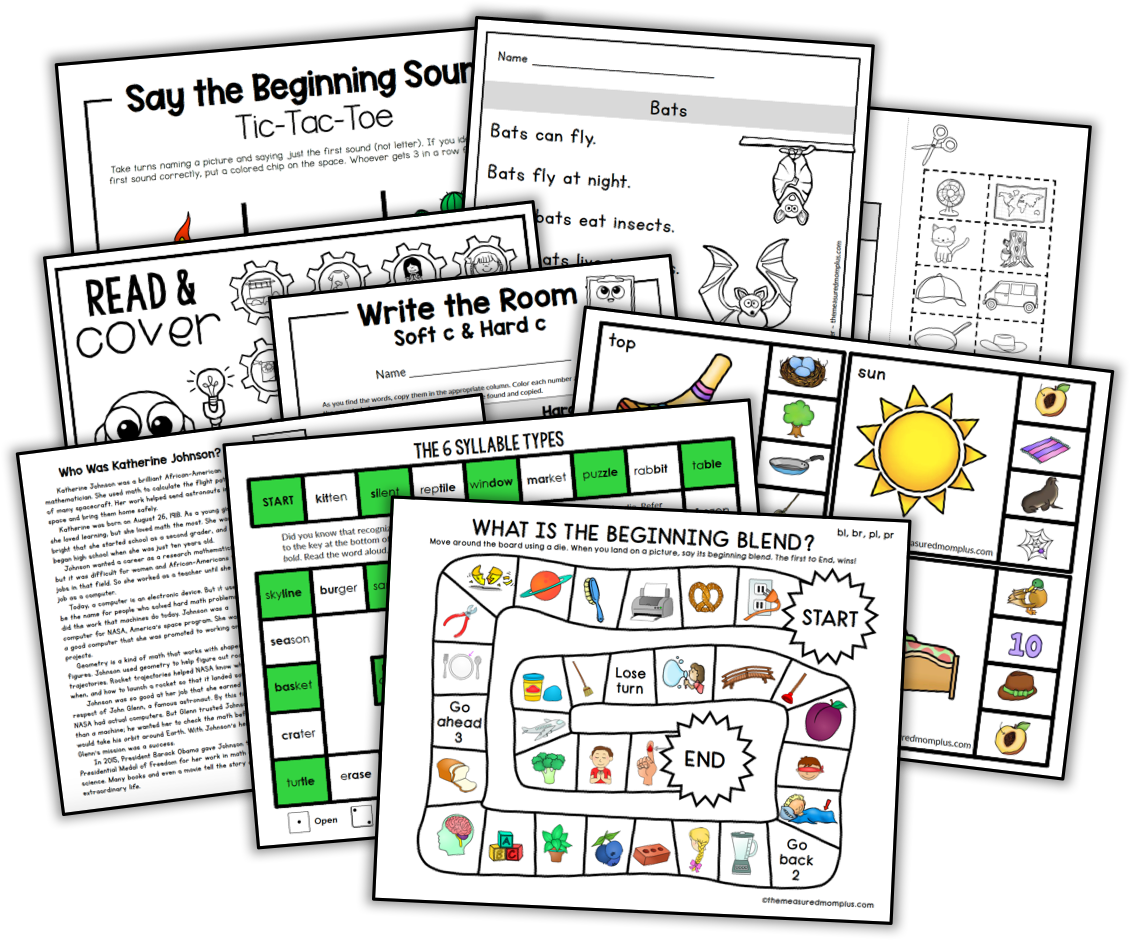Nursery rhymes aren’t just fun to sing. They’re also a great way to teach concepts of print!

What are “concepts of print,” anyway?
Concepts of print are basic understandings about letters, words, sentences, and books.
- Knowing how to hold books correctly and turn pages in the right direction
- Understanding the difference between a letter, word, and sentence
- Knowing that each word on a page represents a spoken word
- Understanding that text is read from left to right
Don’t kids develop concepts of print naturally?
Sometimes. If you read a lot to your child, he may internalize these concepts without any special teaching from you. But for many children, explicit instruction is necessary.
My Nursery Rhymes Concepts of Print Pack fits the bill!
Why nursery rhymes?
There’s a reason nursery rhymes have been around for hundreds of yours. They’re catchy. Kids love them. Best of all, they’re easy to remember.
Tell me about this pack!

The pack comes with ten printable emergent readers (in both color and black & white). When your child already knows the rhyme, he can recite it while pointing to the dots under each word.
I noticed that my Four had trouble when reciting “Twinkle, Twinkle, Little Star.” He wanted to make “diamond” two words, since it has two syllables. But then he ended up on the word “the” too soon. Since he knows how to read that word, he got stuck and started the page over.
Same problem.
“This is too hard! I don’t want to do this anymore!”
I knew we needed to start with a different activity from the pack.

I printed the pocket chart sentences, and on a different day we put the rhyme together. Seeing the words as separate cards really helped it click.
He loves “reading” with our fun pointer, and he did great! Each time he got stuck (on “above” and “diamond”) he started the sentence over and was able to see that each of those words is a single word.
(And when I gave him the book to read afterward, he “read” it perfectly.)

This is another great hands-on activity. I sit next to him, read each line of the poem, and he builds it with linking cubes – using one word per cube. Afterward, he counts the blocks and I write the number of words for each line.

Here’s a simple letter, word, and sentence sort.

When I told my son to circle a word, underline a sentence, or cross out a letter, it opened my eyes to what he does and doesn’t know about concepts of print. He’s getting better and better at these activity sheets!

Here’s another page we did together. I read each line, and he used beginning sound clues to figure out the missing words. (Note: This is NOT how we want to teach beginning readers to read, but I used this as a pre-reading activity to reinforce letter sounds.)

What a great printable for teaching how to follow text! My Four starts at the green dot and moves to the right, reciting each line. Then he moves his finger to the green dot on the next line and recites again.

This just may be my favorite activity from the pack. Each rhyme comes with a “Glue and Draw” page in which your child reconstructs a sentence from a rhyme and illustrates it.
My Four cuts out the words, I tell him the sentence, and he rebuilds it by finding each word using beginning sound clues.
At first, he chose the word “what” when trying to find “wonder.” (Because they both start with “w,” of course.) Then he looked more closely. “This one is ‘wonder’ because it ends with an r.”
Such a wonderful lightbulb moment! Your child will have lots of them when you use the activities in this pack.
GET ACTIVITIES FOR 10 POPULAR RHYMES!

Nursery Rhyme Concepts of Print Pack – Set 1
$15.00
Since children love nursery rhymes, these classic poems are the perfect text for teaching concepts of print. This file contains 280 pages of printable activities featuring ten different nursery rhymes. The file includes instructions for how to teach concept of word, voice to print matching, and more.





Sarah
My son loved this pack! He is a reluctant learner, but he really enjoyed this. What is the next step? Any recommedations?
Anna G
Hi Sarah! If you send me an email – anna(at)themeasuredmom(dot)com you can tell me exactly what he knows regarding letters, sounds, sight words, etc. and I can give you a next step. 🙂
Sharon
Love these ideas.
Anna G
I’m so glad, Sharon!
Naomi
This makes me happy!!! First, because I feel there are so few activities for nursery rhymes (if I had time, I’d write up a whole well-rounded, hands-on based curriculum!) and second, because I am looking for things like this to use at home with my children as well as in my preschool classroom. This is right where we are right now (two preschoolers at our house right now) and it looks like fun! For anyone else reading this, I would highly recommend that CD of nursery rhyme songs…I bought it last summer to use in my classroom this year and all the kids know the rhymes so much faster with the songs AND the actions together, rather than just the songs. And even with just the songs last year, I think most of them didn’t even know them just singing them once a week in our class. Thanks for a great article and most likely a great bunch of activities! I can’t wait to start. 🙂
Anna Geiger
Thank you so much, Naomi! I think nursery rhymes are such a great learning tool – so easy to learn and there are so many possibilities with them. We’ve been listening to the CD in the car the last few days. Such a fun one!